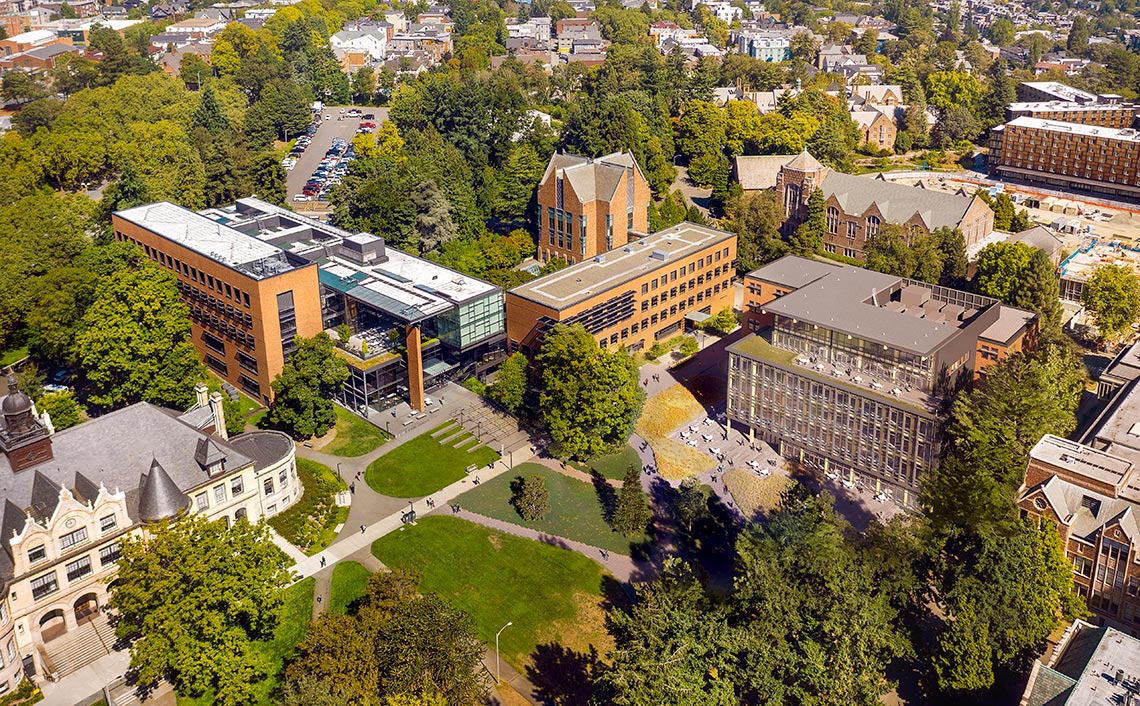(LMN Architects)
Good Bones
Founders Hall will be constructed with cross-laminated timber, the state of the art in engineered wood that is healthy for people and the planet
When it opens in 2021, Founders Hall will add classrooms, student team rooms and much-needed space for the UW Foster School’s student programs, career services and experiential learning centers. The 85,000 square-foot multi-use facility will replace Mackenzie Hall in its current location.
There are several significant milestones associated with this project. For one, the estimated costs of $75 million are being funded entirely by private gifts from a consortium of leadership donors—literally the “founders” of the new hall.
Additionally, the new facility will be the first building on the UW campus—and one of the first in the state—to incorporate the newest innovation in construction materials.
Get ready, because the future is here, and it’s… wood.
Not just any wood. Specifically, cross-laminated timber (CLT), an advanced engineered wood made from layers of pressed lumber that can be machined into large, beautiful shapes with accuracy to the thousandth of an inch.
There are tremendous performance advantages to CLT as a structural building material strong and rigid enough to replace steel and concrete.
Back to our roots
It may be hard to think of wood as the cutting-edge innovation in building construction—isn’t that what we used before concrete and steel?
However, the way in which older wood buildings were constructed didn’t lend itself to urban growth, which demanded greater cost efficiencies and lesser risk of fire. In a region that is now known internationally as a high-tech hub, the timber industry has also been making revolutionary strides.
Washington state has a long history of timber innovation, including advanced approaches to forest management and sustainability. In fact, the UW School of Environmental and Forest Sciences is one of the oldest natural resource programs in the country. And researchers at the school recently validated the environmental benefits of building with CLT in a study published in the Journal of Building Engineering.

Why wood is good
The benefits of CLT are manifest before you even dig into the environmental science. Let’s start with the aesthetics of a beautiful wood finish and give a nod to what is widely regarded as the positive impact of bringing the outdoors inside when it comes to mood and ambience. Of course, the same benefits hold true for how a building of mass timber blends into its environs. CLT also has the edge over conventional materials in biaxial strength, durability, stability and acoustic qualities.
There also are numerous environmental benefits.
Trees naturally sequester carbon dioxide, and they continue to do so even after being converted to CLT. Founders Hall will be a carbon sink.
Further, CLT derives from responsibly managed forests that aren’t depleting natural resources, but being harvested and regenerated sustainably like any well-managed agricultural crop.
The manufacturing process for CLT is also considerably easier on the environment than other materials. UW researchers calculated the average building constructed with CLT to have a 26.5 percent smaller carbon footprint than a comparable one constructed with concrete.
The Lorax would approve
The construction of Founders Hall will be a partnership of Hoffman Construction, LMN Architects and McKinstry. Dean Allen (BA 1976), McKinstry’s CEO, says that CLT production is good for the state’s timber industry and for the health of American forests.
Because CLT is a composite, it can derive from smaller diameter trees than the ancient giants of older-growth forests. Managing sustainable timber harvesting requires strategic “de-loading” of these smaller trees to create clearings that help avert the spread of forest fires.
They also create new opportunity in the industry. “The smaller trees we want to remove are abundant,” says Allen. “And smaller mills can handle them, which also creates jobs.”
He notes that CLT has given rise to Katerra’s new state-of-the-art mass timber factory in the Spokane Valley.
Time is money
One other advantage is that CLT comes manufactured to the job specifications and ready to go—think “time is money.” The expedited schedule essentially saves interest carry on the deferred capital and will allow the project to be completed with greater speed.
What about the downsides? “Well, there are new things to learn—a curve that hopefully flattens out over time,” says Allen. “Issues include wondering whether codes are up to speed and ready. But that’s a risk factor that’s been ameliorated. Use of CLT is a few decades old in Europe, and there are hundreds of buildings proposed.”
Beyond proposed is Founders Hall, whose construction is set to begin in spring of 2020. The newest piece of the Foster School campus will be up before you know it, erected with acres of gorgeous cross-laminated timber that is healthy for people, healthy for the planet and a beauty to behold.
You could say that where wood is concerned, there’s nowhere to go but up.
